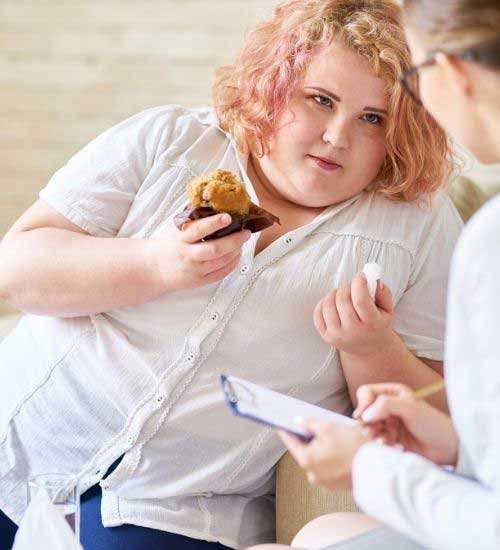
Eating disorders Definition: Eating disorder is a type of mental ailment.
You may eat foods to control your mood.
However, persons with eating disorders have an unhealthy link with foods.
This may eat excessive or inadequate foods.
You may become obsessed if you have an eating disorder.
An eating disorder may occur to anybody.
No matter the culture, age, gender, or ethnic background.
It is calculated that about 30 million people disorder in the United States is suffering from eating.

Read More: 6 Useful Home Remedies for Insomnia or Sleeping Disorders: 100% Works
Types of Eating Disorders:
There are different types of eating disorders. This article will cover Anorexia Nervosa, Bulimia Nervosa, Binge Eating Disorder, and ‘Other types of Identified Eating Disorders.’
1. Anorexia Nervosa:
A person with anorexia always tries to keep their body’s weight as low as possible.
He or she may think they are becoming overweight even though others say you are seriously thin.
This category of people may panic, gaining weight and discourage them from eating more.
# Behavioral Symptoms of Anorexia Nervosa:
- Eat faster than normal during a binge.
- Eat when they are not hungry and until feeling uncomfortably full.
- Eat alone or secretly.
- They have feelings of guilt, shame, or disgust after being eating.
- Low confidence, depression, and stress.
# Physical Symptoms of Anorexia Nervosa
- Overweight for age and height.
- Exhaustion and sleeping difficulty.
- Constipation and swelling
Read More: Foods for Depression and Anxiety: Should or Shouldn’t Eat
2. Bulimia Nervosa:
A person with bulimia is commonly suffered from an unhealthy eating phase.
They usually eat lots of food and then try to do something for weight loss. They may make vomit, take cathartics, or over-exercise.
This type of eating is called ‘binging’ or ‘vomiting.’ A person with Bulimia Nervosa will commonly have normal body weight.
Other people usually do not see having these problems.
# Behavioral Symptoms of Bulimia Nervosa:
- Feeling guilty after bingeing and purging.
- Are influenced by food.
- Unable to control their eating.
- Have an unfair view of their body form or weight.
- Have mood fluctuation.
- Secretive about purging and bingeing.
- Feel nervous and stressed.
- Can be linked with depression, low confidence, and alcohol abuse and self-damage.
# Physical Symptoms of Bulimia Nervosa:
- Fading soon after eating.
- Bumps on the backside of the hand. These are occurred by driving to be sick.
- Stomach pain, inflating, and constipation.
- Digestive problems.
- Being exhausted and not having liveliness.
- In girls and females – menstruations stop or irregularity.
- Repeated weight changes.
- Hands and feet puffiness.
3. Binge Eating Disorder (BED)
A person with a binge eating disorder usually eats lots of food in a short time regularly.
As with bulimia, they won’t feel control of eating. It is happened due to grief.
They may feel disconnected and forget what they have consumed.
# Behavioral symptoms of Binge eating disorder:
- Eat quicker than usual in the period of a binge.
- Eat when they are not hungry and until they feel awkwardly full.
- Eat alone or behind somebody’s back.
- Have feelings of guiltiness, shame, or disgust after binge eating.
- Low confidence, depression, and stress.
# Physical Symptoms of Binge Eating Disorder:
- Overweight for your age and height.
- Exhaustion and sleeping problems.
- Impairment, and bloating.
Read More: Most Common Food Allergies in Children: 10 Questions and Solutions
Other Eating Disorders and Problems:
Besides the above-mentioned three types of eating disorders, people may have other eating disorders and problems.
This does not mean that your disorder is less severe.
# Orthorexia Nervosa:
Orthorexia is not a familiar clinical diagnosis.
But many persons fight with these symptoms.
Orthorexia happened if you give too much attention to eating food for feeling more healthy and pure yourself.
It may start as a healthy diet but becomes harsh and compulsive.
You may become disconnected from society for the reason that your plan your life around food.
#Pica:
A person with pica may eat non-nutritional or non-food objects, for example, paint, chalk, stones, and clothing.
Some of these objects may pass through our bodies without harm.
But pica can be very risky.
It can cause some health issues, for example, stomach and dental problems.
We generally don’t realize what causes pica.
#Chewing Disorder or ‘Chew and Spit:
Somebody may chew and spit out food without absorbing it.
They may do this over and over.
#Selective Eating Disorder (SED)
Persons with selective eating disorders may eat certain foods or may refuse to try other foods. SED is common in young children.
But the problem can continue into middle age.
How to diagnose Eating Disorders?
Doctors use different strategies for diagnosing different eating disorders.
Procedures say which symptoms you should have and how long to get a specific diagnosis.
These are the main recommendations:
- International Classification of Diseases, formed by the World Health Organization (WHO)
- Diagnostic and Statistical Manual, developed by the American Psychiatric Association.
Read More: Top 11 Herbal Remedies for Depression and Anxiety
A health professional will help you to diagnose. As part of the judgment, they will:
- Ask about your feelings, opinions, and activities,
- Doctors will observe if there has been any quick weight loss,
- Doctors will check your body mass index (BMI) is very high or very low,
- Doctors will ask about your diets,
- They may ask about your relationships, job, etc.
Eating Disorders Causes:
We don’t know the exact causes of eating disorders.
Many people think that eating disorders occur due to social pressures to be thin.
Social pressures could be fashion magazines or social media.
Others believe that it is a technique to stay in control.
Maximum experts believe that eating disorders happen because of mixing mental, ecological, and genetic issues.
# Mental Factors Could Be:
- Becomes weak to depression and anxiety,
- Feel stress tough to handle,
- Upset a lot about the future,
- Wants to be a perfectionist,
- By controlling your emotions,
- Have obsessive feelings.
- A panic of being fat.
# Environmental factors could be:
- Too much pressure at school.
- Harassment or Abuse
- Having criticized for eating habits or body shape
- Having problems in family relationships
- Having difficulty in a job or hobby where needs to be thin is perfect, for example, dancing or sports.
# Genetic factors could be:
Read More: Best Organic Cosmetics Concepts: Everything You Need to Know
- Ups and downs in the brain or hormone levels.
- The family history of eating disorders, unhappiness, or substance misapplication.
What should I do for an Eating Disorder?
The first step is to visit your doctor. They can send you to an expert if required.








